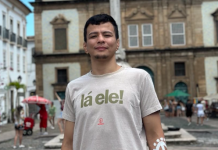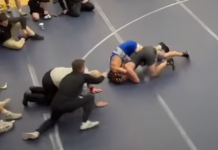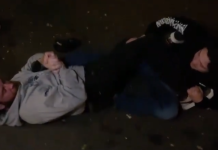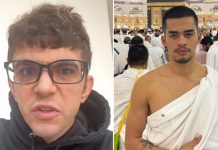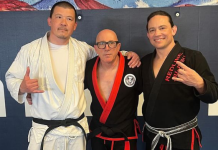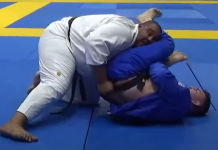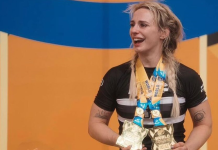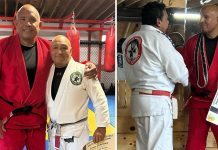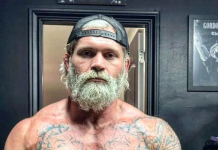While some say that winning silver stings worse than not placing at all, for 10th Planet’s Keith Krikorian, his previous second-place finishes as ADCC Trials may have given him the fuel he needed to win gold at West Coast Trials earlier this month. “I’ve made a lot of mindset shifts over the past year,†Krikorian tells the Jiu-Jitsu Times. “When I first did the Trials, I had no expectation of winning them – I truly was just thinking that it would be a good tournament to give me experience. If I won a few matches, great, if I lost the first match, well, that’s just the experience I’m looking for. So when I made it to the finals – or even the semi-finals – I wasn’t really focused on the fact that a win would get me to ADCC. I was just amazed that I’d made it that far. So, going into the finals, I didn’t put much pressure on myself to win. In a lot of ways, that can help you, but in certain ways, it doesn’t, because you won’t fight as hard, and you’re not as committed to the goal at that point.â€Â

What changed this year? “This past Trials, I was really focused,†says Krikorian. “I was committed, and I was thinking to myself, ‘This is it.’†He adds, “A lot of this past ADCC Trials was also about being more aware of [the ADCC points system], aware of the strategy, but also just let myself fly. A big part of my game is having a submission threat at all times, and that will help me score if I can use it – but if I just throw subs and don’t threaten sweeps and passes and back takes and stuff, it doesn’t work as well. So I feel like I’ve combined a stronger element of my game with growth in what was previously a weaker part of my game.â€Â
According to Krikorian, there’s nothing quite like the feeling of punching your own ticket to ADCC at Trials. “I was invited to [ADCC] Worlds last time, but it was only of two second-place finishes at the Trials, which obviously I was excited about, but you can’t be too proud of failing twice, and still getting invited,†he explains with a self-deprecating laugh. “So it just felt way better to actually feel like I earned my way there, especially against the quality of guys I faced at this Trials. It’s a much better feeling than just losing and still getting invited.â€Â
Which isn’t to say that second place is anything to sneeze at in a competition as tough as ADCC Trials. In his previous Trials, Krikorian earned hard-fought submission wins against some of the most dangerous players in the sport, including the much more experienced Gianni Grippo. “I game planned pretty specifically for him because I noticed a few things that he did consistently,†remembers Krikorian. “You have such a benefit, being the lesser-known guy, going against someone like [Gianni], because there’s so much footage of him, but [at the time], not much of me. I’ve been watching him for years – he’s probably been a black belt since I started training. So I watched him a lot and noticed tendencies of his that I was really well-prepared for. I don’t know if he would have been as familiar with my game – so maybe that caught him off guard.â€
“I had never actually seen him get submitted, so I wasn’t by any means expecting to actually lock in a choke,†confesses Krikorian. “When I shot, and he exposed his back, I was really focused on my hooks – and I was really just using the threat of a choke to get a second hook in. But then it was one of those things where he was defending the hook, so he couldn’t defend the choke, which is how I got the choke in. But I think that if we had another match, it would go very differently. I think [Grippo] would be much better prepared for my leg lock game and my wrestling. My win against him was really like a one in a million shot, which was a pretty cool moment for me.â€
According to Krikorian, he doesn’t take any of his opponents lightly, but at the most recent Trials, he was particularly wary of Ares BJJ standout Josh Cisneros. “I had to take every match very seriously, but I’d say that the opponent I was most nervous about was [Cisneros],†says Krikorian. Part of that worry stemmed from Cisneros’ previous victory over Krikorian in a 2019 Fight to Win match. “[Cisneros] actually beat me pretty good [that time],†says Krikorian of their Fight to Win match. “I guess it was a close decision under Fight to Win scoring, but in my eyes, I definitely got my a** kicked. He just felt like a very complete grappler. He felt much physically stronger than me at the time, and he felt like a much better grappler than I was. So going into another match with him, in my mind, it’s like, ‘Well, how do I know anything’s changed?’ He could have just been getting better this whole time and just staying a few steps ahead of me. So that was definitely the one I was most concerned about.â€
Krikorian hopes to see Cisneros invited to ADCC. “He’s so solid all-around,†says Krikorian. “Good wrestling, good leg defense, good passing, good back takes – really diverse back attacks, especially. Those Suloev stretches he was hitting, that was next-level stuff, especially with the guys he was hitting them against. I truly believe that he’s ADCC caliber, and I think that he should get an invite. I think he’d do really well, and I’d be really excited if I got the chance to match up against him again. I’d definitely like to feel more of his game.â€
Are there any other potential opponents Krikorian hopes to face at ADCC this year? Plenty, though off the top of his head, he relishes the prospect of a rematch against Cole Abate, to whom he lost at a previous Trials run. Krikorian, who felt that he under-estimated Abate the first time they squared off, would play a very different game if they were to meet on the mat again. “I forget just how experienced that kid is, and the quality of his coaching team and game planning,†admits Krikorian. “They did a really, really good job capitalizing on my naivete.â€
How would Krikorian approach Abate differently now? Primarily, he’d work on tailoring his own game to the ruleset. “If we match up at ADCC [Worlds], I can’t be the same guy that I was,†says Krikorian. “I had no concept of a points strategy the first time [we matched up] – I was just trying to throw subs at all times, no matter where the match was. I was just trying to sub everyone. And that works well, mostly, but there’s that point where you go up against a real ADCC caliber guy, and you hit the period in the match when points are on the board, and you make one mistake – because you were trying to fall back on a leg, or jump for an arm or a neck – and he comes upon two points, so you’re behind. And it’s so hard to recoup points under ADCC rules. So if I were to do it again, I’d just be much more cognizant of points.â€
Another major adjustment for Krikorian has been finding the right balance between technique training and a functional strength and conditioning regimen. “I’d say that the past year and a half has been about dedicating a lot more time to getting stronger – but also a lot more time to the technical aspects of my training. I never used to lift, I never used to drill, and I never used to put much thought into studying jiu-jitsu. I’d just go in and half-ass the technique, joke around with my friends during class, and then roll hard. I could roll harder than anyone, for longer than anyone, which is a great skill – and I think it mentally equips you for tough matches – but you don’t get much better just doing that, in my opinion. I think it makes you tougher, but not better.â€
The difference between “tougher†versus “better†is one that Krikorian has learned through grueling firsthand experience. “I think there’s something to be said for prioritizing toughness at the lower belts – I do think it’s a good thing – but once you get to maybe a brown belt or black belt level, there’s a huge learning curve. For me, at least, when I started competing at that level, I felt a big difference in the other guy’s level of strength, and how much sharper his technique was – and on top of that, they could push just as hard as I could.â€
Never one to let a good lesson go to waste, Krikorian got down to business correcting his shortcomings. “I totally had to start from scratch,†he admits. “I had to dedicate time to strength and conditioning – which I had never done – I had to build a strength base, and add on my conditioning and stuff. And I had to dedicate way more time to studying and drilling – those are two things that I was really lax about in my training [as a lower belt]. And once I started to do that, I started noticing huge improvements. I was rolling less, but when I was rolling, I just felt much stronger. And I don’t just mean physically – I felt like my game was much sharper.â€
“Assessing what I needed to improve on was never something I used to do,†Krikorian reflects. “When the leg lock craze was happening, I was like, ‘okay, I’ve got to work on leg locks.’ When EBI overtime was getting big, I was like, ‘f***, I’m not equipped for this at all, I’ve got to work on my back and armbar defenses.’ But aside from that, I didn’t really look at my game objectively and identify the things I needed to improve. So once I started to do that, I noticed a major improvement.â€Â
That said, Krikorian’s reluctant to sell his own experience as a one-size-fits-all formula. “It’s a case by case thing,†he says. “Some guys are naturally really strong with no cardio, so they would probably need to do the opposite of what I did, and really work on building that cardio base, while not having to do as much to maintain their strength.â€
He’s also well aware of the open secret in the jiu-jitsu community of the number of PEDs being peddled around gyms. “The reality is, a lot of guys are taking supplements and performance enhancers that are going to make them a lot stronger,†he states frankly. “Which is fine, it’s not against the rules, so I have no problem with it – but it’s not personal for me.†He laughs. “I just deal with enough health issues from jiu-jitsu as is, so the risk [from possible side effects] isn’t really worth it for me. So I’m not willing to do that, but I am willing to build a little more strength in the ways that I can.â€
Does the idea of facing an athlete on PEDs bother him at all? “Not really,†says Krikorian. “I truly don’t care [what other athletes choose to do]. It’s not that annoying to me. If anything, it just motivates me to work harder. It’s a slower process, but it works for me.â€
Krikorian, like most elite jiu-jitsu athletes, has also had to deal with training around injuries. “I had an injury this past year that forced me to take a step back,†he says. “All I could do was lift, and study, and slow drill after that. And that made a huge difference. There was a bit of a learning curve, but once I came back from the injury, I felt a little more comfortable. I’m still kind of tweaking with it – I think I did a few things wrong this last camp, and I’ll probably do a few things wrong in the next camp, but hopefully, long term, I can figure it out, and just keep building on what I’ve got so far.â€
What advice does he have for other jiu-jitsu players who have been partially or fully sidelined by injuries? “There’s always stuff you can be doing when you’re injured,†says Krikorian. “It’s frustrating, but it’s such a good opportunity to improve in other areas, and really appreciate the time that you do have for training. It’s frustrating to do it too often, but I truly think it’s a very good thing to step back every now and then.â€
The biggest change for Krikorian by far between his East Coast and West Coast Trials has been his mindset shift: “One thing I took away [from East Coast Trials] was that I don’t have to no-sell all my wins – I can allow myself to be happy or proud in the moment, as long as I remain focused. I think maybe I was too focused in my East Coast Trials – I didn’t allow myself to have any fun, you know? It’s just a general mindset shift: enjoy everything. I enjoy waking up and feeling groggy, and I enjoy waking up and feeling good. I enjoy going to training and feeling terrible, or going to training and feeling great. You have to take the good and bad for what it’s worth, and let yourself be happy. You don’t have to be miserable. I used to think that to be good at this sport, you had to suffer – that’s what everyone told me in wrestling – but at a certain point, you’ve got to make sure that you’re happy.â€
“I try to be as real with myself as possible,†Krikorian elaborates. “In my mind, I’m still pretty terrible at this thing that I’ve spent the past ten years doing!†He laughs. “I think it’s important to acknowledge that I’m going to lose, that I’m probably going to lose to guys I shouldn’t. I might beat some guys I shouldn’t too – that’s all part of the game. But you’ve got to be prepared to embrace the journey as a whole.â€
He’s grateful to his coach, Richie “Boogey†Martinez, for a strong rapport that’s helped Krikorian grow in leaps and strides over the course of that journey. “We instantly clicked,†says Krikorian of his first meeting with Boogey. “I don’t know what it was – we knew nothing about each other – but it’s like we just totally vibed right off the bat. I definitely saw a work ethic in him that I wanted to have as well. Even when I went to college, and was trying to figure out where I was going to train, he was like, ‘Don’t worry about it, we’ll figure things out, you’ll always be my student.’ So when I went to school, he made sure that I got in touch with the right people and still got the right training.â€

To what extent has 10th Planet’s unconventional no-gi syllabus informed the development of Krikorian’s personal jiu-jitsu style? “I think you have to credit the no-gi explosion to two things: Eddie Bravo, and to John Danaher and the DDS,†says Krikorian. “I think those are the two of the main components that just made the no-gi scene absolutely explode. Eddie, shortly after his second Royler Gracie match, just reached a new level of fame and respect [because of his performance]. And around that same time, the Danaher guys were coming up and revolutionizing the no-gi game. I was in high school around that time, maybe fifteen or sixteen when that was happening, and I got to see it firsthand. So I really followed their blueprint.â€
That’s still how Krikorian learns, to this day. “Anything Eddie’s upon, I make sure I’m upon,†he explains. “Anything that [the DDS alumni] are doing, I’m also following and studying, whether it’s reading John Danaher’s posts, watching B-Team videos, or studying Gordon and Garry’s matches. I’ve got my ear really close to the ground with them.â€
“It’s all about staying up on any trends that are playing out in front of you,†says Krikorian. “Whether it’s leg locks, EBI overtime, or wrestling – which is really big now, especially with ADCC being as big as it is. And I think it’s really important to stay on top of that stuff, or you get left behind.â€
So, how’s Krikorian going to fill the time between now and ADCC 2022? With a lot of action, as it turns out. Up next, he’s got a GrappleFest match against Welsh-born grappling star Ashley Williams on May 21. On June 5, he’ll be in the CJJ Worlds: Lightweights – where he’ll also share a bracket with Williams. That same month, on June 25, he’ll be on Polaris’ Team USA, facing down the Brazilian team. His own coach, Boogey, will be serving as team captain, which has Krikorian particularly excited for the international showdown.
For your chance to catch Krikorian in action before ADCC 2022, tickets to GrappleFest are available on EventBrite. Afterward, tune into CJJ Worlds: Lightweights and Polaris on UFC FightPass.
To stay up to date on other upcoming matches and events, follow Krikorian on Instagram.






